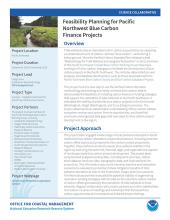
Tidal wetlands are some of the most economically important yet vulnerable ecosystems globally. Over recent decades as wetland restoration has garnered growing attention, more widespread and larger restoration projects are being undertaken around the world. However, restoration projects are often costly and limited in funding. The creation of voluntary carbon markets and the development of methodologies that include tidal wetlands in the market have created new opportunities to finance coastal restoration and conservation.
Since 2013, The Pacific Northwest Coastal Blue Carbon Working Group has been working to fill blue carbon data gaps and bring stakeholders together in support of coastal wetland conservation in the Pacific Northwest. The group led this 2018 Catalyst project to demonstrate the feasibility of including carbon finance in funding strategies that support the conservation and restoration of tidal wetlands, eelgrasses, and coastal lowland sea level rise buffer areas. The project evaluated the viability of blue carbon projects at two sites in Washington (Snohomish and Skagit Estuaries) and one in Oregon (Coos Estuary) and advanced local stakeholders' understanding of next steps for blue carbon management and financing in coastal communities.
About this resource
This overview highlights the project approach, results, benefits, and next steps.